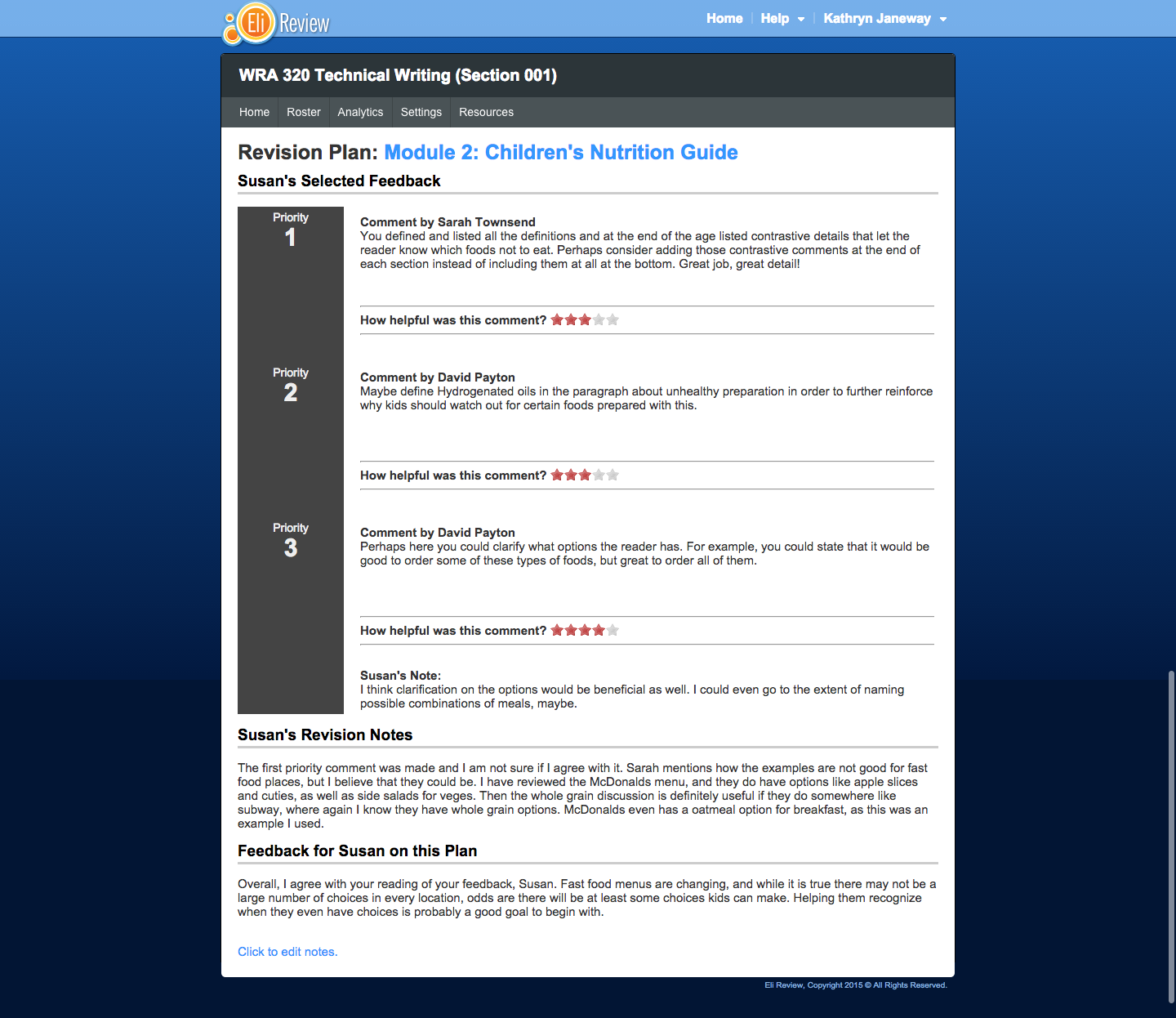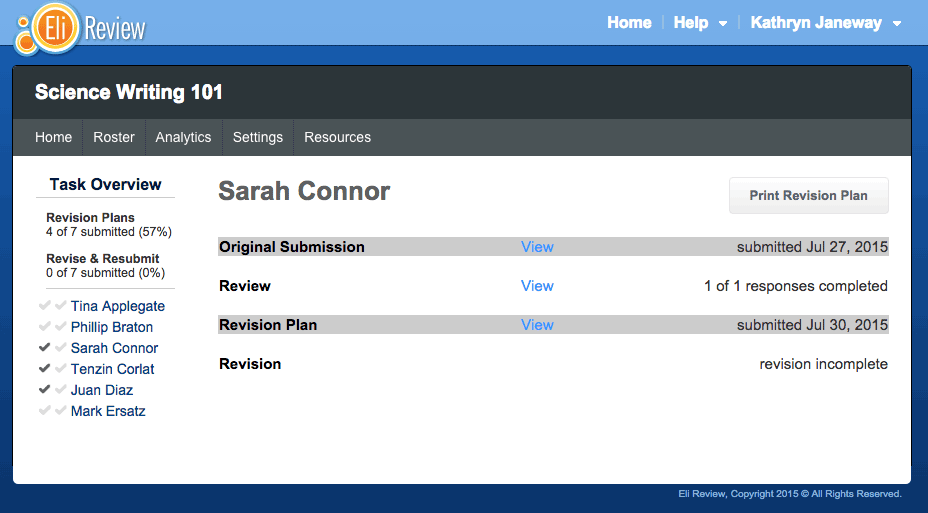When conferencing, instructors talk with students about how to improve their writing. Eli Review supports that goal by aggregating all the tasks students complete: drafts, feedback, revision plans, and revised drafts. These artifacts help instructors understand writers’ learning in the context of the feedback they’ve received.

This brief tutorial addresses why instructors might consider conferencing, offers strategies for using Eli for conferences, and summarizes analytics that facilitate such conversations.
Writing teachers are trained to conference with students about their writing*. NCTE’s beliefs about teaching writing states: “Writing has a complex relationship to talk,” and the core pedagogy is conferencing. Florida State’s types of conferences resource describes what these conversations can do for students at different points in a writing process. Similarly, the University of Wisconsin’s “Preparing for Effective Conferences with Students” identifies ways instructors can make room in their syllabus for one-one-one discussions with students.
This resource focuses on strategies for incorporating conferences into rapid iterations of feedback. Because feedback is critical for revision and learning, Eli Review can increase the proportion of review and revision students complete. Since Eli can deliver a high volume of peer feedback and since instructors can coach writers and reviewers using Eli’s review analytics, instructors can schedule conferences to help students sift through the feedback they’ve received.
*To learn more about conferences, see these resources from NCTE, “Teaching in the Present,” 2015; for K-12, Prince, “Framing the Conversation: How the Experts Approach the Student/Teacher Writing Conference,” 2015; for college, Lerner, “The Teacher-Student Conference and the Desire for Intimacy,” 2005; for college, Hewett, The Online Writing Conference, 2015.
To prepare for conferences using Eli Review, consider three factors: timing, student prep work, and instructor prep work.
Eli Review enables instructors to design rapid feedback iterations:



Sequences like these give writers multiple opportunities to get feedback from reviews that target a few criteria each time. Focusing reviewers’ attention and writers’ efforts on a few criteria reduces the cognitive load and increases their chances of performing well, especially if instructors are coaching the whole class using trends, models drafts, and model comments. This pedagogy makes peer learning effective (for more, see Feedback and Revision).
Because effective peer learning can do much of the heavy lifting, schedule conferences at those points in a project where peers are unlikely to be able to address higher order revisions (e.g., claims, organization, evidence):
If you’re saying the same thing to every student in your conferences, coaching the whole class would have been more efficient. Use conferences to go beyond the concepts emphasized in peer learning.
The other factor in timing conferences is making sure writers have adequate time to respond to your coaching. Giving students at least 3-5 days to revise after the conference ensures that they’ll have enough time to revise.
Make sure students attend conferences with a sense of purpose by having goals for the conversation and for the revisions that follow.
In Eli, students can clarify their purpose and goals by rating their feedback and completing a revision plan. Revision plans are an important part of Eli’s scaffold and can be assigned for every writing task.
Not every revision plan, however, merits a conference; as rule of thumb, every conference merits a revision plan.
Creating a plan in advance of a conference can help students accomplish three things:

Writers’ notes in revision plans ensure that the conference addresses writers (their needs and goals), not merely their writing. On this point, The University of Wisconsin’s “Conducting Conferences” resource quotes Robert Connors and Cheryl Glenn, from the 3rd edition of The St. Martin’s Guide to Writing, 3rd ed. New York: St. Martin’s, 1995 (now in its 7th edition, which does not include this passage):
If your purpose in a conference is to respond only to the student’s text, you might as well take the papers home and leave the student out of the process altogether. Instead, you should be making room for students to articulate what they know or sense. . . . Ideally, you respond to the student’s response to the text. You respond fully and immediately, not only to what is on the page but to what isn’t on the page: intention, process, ideas for revision, and so forth (41)
By talking with students about their revision plans in the context of all the work they’ve done previously and all the feedback they’ve already received, instructors engage with students’ thinking, which deeply impacts their learning.
Eli Review makes it easy for instructors to quickly read through all the artifacts of writers’ work from two locations:

A sequence for working through students’ artifacts might look like this:
Instructors’ challenge (as always) is making the few minutes of the conference count. Given the visibility Eli provides, instructors can quickly prepare for good conversations with writers about their next steps.
This tutorial covers ways to use Eli while conferencing with students. Related resources include: